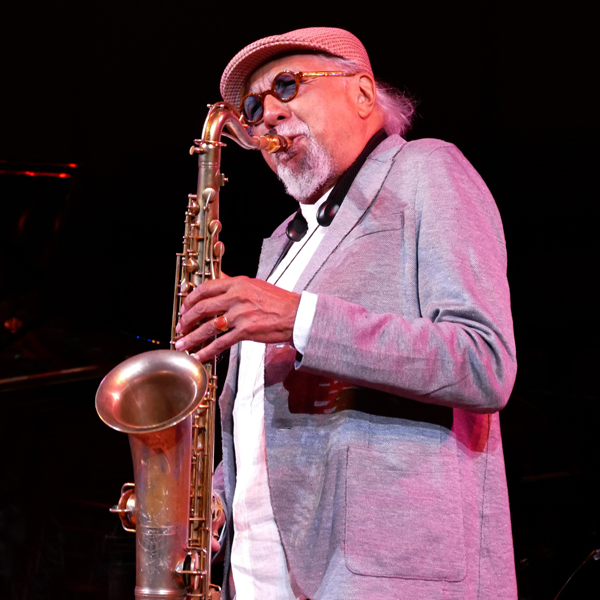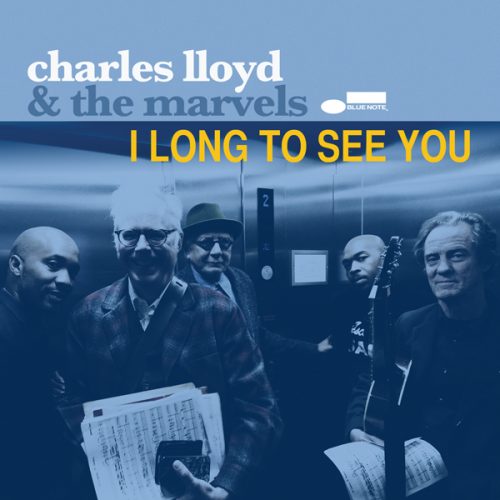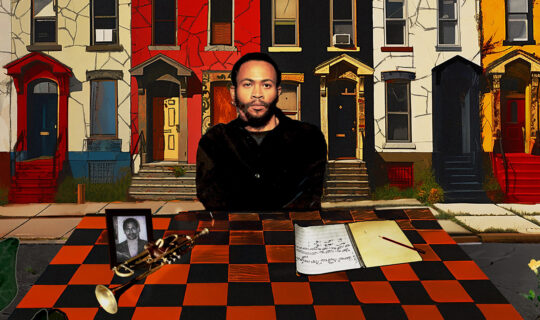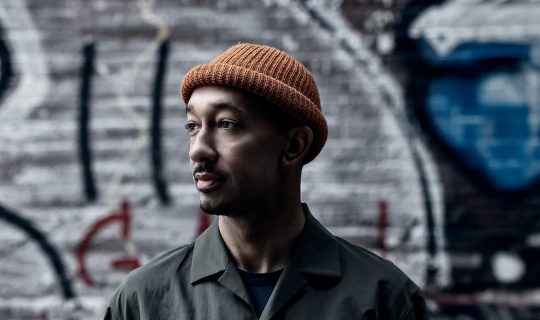January 20, 2016
In 2015, iconic saxophonist Charles Lloyd continued his innovative trajectory into the upper spheres of jazz and the spiritual realms of wonder and beauty. He basked in a banner year that included receiving the National Endowment for the Arts Jazz Masters honor and marking a triumphant return to Blue Note Records with his remarkable live album Wild Man Dance. While talking about his “call of the wild” at the time, Lloyd said, “I am still searching to find the sound. It is my path. I call myself a ‘sound seeker.’ The deeper I dive into the ocean of sound, I find there is still deeper and further to go.”
The creative dive progresses on Lloyd’s superlative Blue Note follow-up, I Long to See You, a recording of pristine beauty, refined elegance, passionate emotion and spiritual sensitivity. It features a marvelous new lineup of voices who deliver a sumptuous collection of ten songs that range from traditional hymns to anti-war folk protests to re-envisioned originals that appeared on his earlier recordings. Lloyd has enlisted the rhythmic core of his stalwart New Quartet ensemble—bassist Reuben Rogers and drummer Eric Harland—and invited top-tier collaborators including guitarist extraordinaire Bill Frisell and stellar pedal steel guitarist Greg Leisz. Appropriately Lloyd has dubbed the quintet The Marvels. In addition, I Long to See You spotlights two guest vocalists: Willie Nelson and Norah Jones because as Lloyd says, ‘I love the voice.’” As for the meaning of the title, Lloyd succinctly explains: “In the reservoir of my heart, there has always been this deep longing.”
The seed for the new project was planted in 2013 when Lloyd invited Frisell to perform with him at UCLA’s Royce Hall. They had met earlier that year when they shared a stage, and Lloyd says, “We made a connection. I knew that we were moving toward the sound. Bill is a great sensitive and very intuitive. When he was a kid in Denver, he told me he was influenced by my first band with Jack DeJohnette and Keith Jarrett. He said that music opened his imagination to a wide spectrum of new possibilities. We don’t need to say much when we get together—it’s all expressed in the music, in the sound, the feeling.”
As for adding Leisz into the mix, Lloyd says, “When I knew that Greg was going to be in town during our L.A. concert, I asked him to sit in with us. He and Bill are like two sides of a coin, so amazing things happened during that concert.” While he pondered releasing the live show as his next Blue Note album, his wife, Dorothy Darr, insisted that he head to the studio instead (she serves as a co-producer of the new album with Lloyd and Blue Note president Don Was).
Lloyd’s history with the six-string goes back to his early days in his Memphis hometown. “When I was a kid, I was around Calvin Newborn a lot, and later in high school, I became friends with an amazing pedal steel player, Al Vescovo. Al and I listened to a lot of music and jammed together,” Lloyd says. As a recording artist, he played with an array of guitarists, from his early collaborations with Gábor Szabó, Sonny Greenwich, Robbie Robertson, Roger McGuinn, Tom Trujillo, then later with John Abercrombie and even his stretch in the 1970s playing with the Beach Boys.
As for his other band members, Lloyd says, “Eric and Reuben are one of the continuous fibers of continuity in my music; they understand. We have been together for over a decade and it continues to bloom.”
I Long to See You opens with a slow, anguished reading of the Bob Dylan recording, “Masters of War” (from his 1963 The Freewheelin’ Bob Dylan album), about the military-industrial complex arms buildup, with a howling tenor saxophone edge and the transcendent beauty of the two guitars lightly dancing. Lloyd was introduced to the song by Darr from the Odetta Sings Dylan album. “I related to Odetta’s powerful rendition and Dylan’s deep lyrics, but it wasn’t until Bill and Greg came along that it made musical sense for me.”
Likewise Darr turned him on to folk artist Ed McCurdy’s anthemic anti-war song “Last Night I Had the Strangest Dream,” written in 1950 and here sung by Willie Nelson with graceful tenor support. “When I was living in Big Sur, a friend gave me a copy of Stardust,” Lloyd says of Nelson’s 1978 album of jazz standards. “I recognized a synchronicity between us in his choice of songs. Willie is a very soulful, independent outsider who loves the Zone. He has been paving the Freedom Trail for many years now, and we follow in his wake. I was incredibly honored that he accepted the invitation to sing on ‘Strangest Dream.’”
For the traditional vein in the album, Lloyd gives a duende read of the lyrical “La Llorona,” which he previously recorded on his 2009 ECM quartet album Mirror. Here his gentle tenor saxophone building to an aching dynamic with the sway of both guitars, especially Leisz’s silvery comps. The sobering beauty of “All My Trials,” based on a Bahamian lullaby of the story of a mother on her deathbed comforting her children but also associated with the 1960s protest movement, brings a spiritual quality to the album, as Lloyd’s tenor goes to the melody’s marrow. The Christian hymn “Abide With Me” (dating back to 1861) features Lloyd on a melancholic tenor lead with Frisell shadowing his notes. And Lloyd brilliantly takes on one of the greatest tunes in the traditional American songbook, “Shenandoah,” with him taking the sublime tenor lead and Frisell playing harmonics and soft lines. Lloyd says simply that he finds the song “transporting.”
As for all the more traditional tunes, Lloyd says that they’re “part of the continuum, one of the threads. It’s all one. We are reflections in the mirror of our time.”
Lloyd and co. also cover some of the leader’s earlier songs, including the great-joy “Of Course, Of Course,” that originally appeared on his 1965 Columbia album of the same name with Szabó, Ron Carter and Tony Williams. Lloyd plays the catchy melody on the alto flute, with killer drums banging away in a robust rhythmic flow, while the two guitars converse with each other throughout. The indelibly melodic “Sombrero Sam” (first recorded on 1966’s Dream Weaver album) has a dance sensibility with an upbeat rhythm opening and then a grooved guitar-slide interchange before Lloyd comes in on the flute to waft over the proceedings. As for his older originals inclusion on the Marvels set list, Lloyd says, “They are markers along the way and have a vibrant light with this orchestra.”
The well-worn song “You Are So Beautiful” (originally written by Billy Preston and made into a hit in 1974 by Joe Cocker) gets a spacious reading here with Norah Jones lending her indelible voice. “During my concerts, I sometimes play it as an encore,” he says. “For a long time in my mind’s ear I could hear Norah’s warmth caressing the lyrics. We’re both from the South. She became an extraordinary, beautiful sixth instrument in the rendition of the song.”
Lloyd concludes I Long to See You with the 16-minute journey piece “Barché Lamsel” that moves across impressionistic soundscapes. Barché Lamsel is a Buddhist prayer to remove all obstacles—outer and inner and secret. “As we started to record the track, it became ‘Barché Lamsel,’” says Lloyd. “There seemed to be no impediments to the flow of notes and ideas. It is a prayer for peace, a sutra for tenderness.”
As for the overall theme of I Long to See You, Lloyd waxes philosophical: “Sound Brahman. Inner and outer peace. Be alert for the eternal as it wells up out of the chaos of the mundane.” He adds: “It’s all in the sound and feeling. The quantum mechanics of love.”







